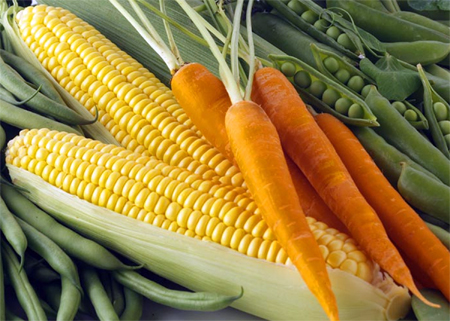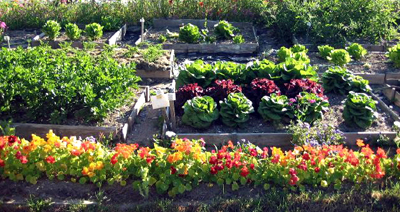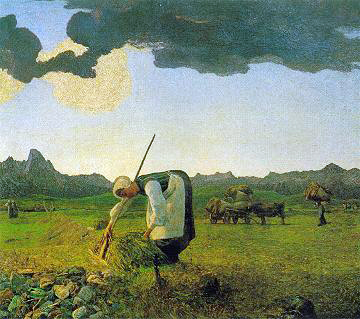
|
|
|

|
|
Volume II
|
August 31, 2006
|
|
|

When to Harvest

The main point behind growing your own vegetables is how much better they taste fresh from the garden. The only failsafe way to guarantee harvesting vegetables at the optimal time is to taste test. However, there are some guidelines for judging when vegetables are ripe and ready for harvest. Keep in mind that great flavor isn't a simple matter of size or color. Without the right combination of soil, sun and water many vegetables can vary greatly in taste and performance.
There are no precise guidelines as to when to harvest your vegetables, but there are some rules of thumb to guide you. Most vegetables are harvested just before full maturity, for maximum flavor and the most pleasant texture. The following are vegetable harvesting criteria for judging whether your vegetables are ready for picking.

Asparagus: Begin harvesting when spears are 6-8 inches tall and about as think as your small finger.
Snap them off at ground level and new spears will continue to grow. Stop harvesting about 4-6 weeks after the initial harvest, to allow the plants to produce foliage and food for themselves.
Beans (Snap): Pick before the you can see the seeds bulging. They should snap easily into two. Check daily. It doesn't take long for beans to go from tender to tough.
Beets: You can harvest and eat the green tops that you thin out of the rows. Beets are really a matter of personal preference when it comes to the right size for harvesting. They are ready any time after you see the beets shoulders protruding at the soil line.
Broccoli: We eat the unopened flower buds of broccoli, so check frequently, especially as the weather warms up, to ensure you don't let the flower heads bloom. Don't expect your home grown broccoli to get to the size of supermarket heads. Harvest when the buds are about the size of a match head.
Brussel Sprouts: The sprouts will mature from the bottom up. You can begin harvesting once the sprouts are at least an inch in diameter. Harvest by twisting off or cutting the sprout from the stem.
Cabbage: The cabbage head will feel solid when gently squeezed. Cabbage needs to be harvested when it reaches maturity or it will continue to grow and split open.

Carrots: Carrots can be hard to judge. The tops of the carrot will show at the soil line and you can gage when the diameter looks right for your variety. If the diameter looks good, chances are the length is fine too. But you will need to pull one to be certain. Carrots can be left in the ground once mature. A light frost is said to improve and sweeten the carrot's flavor.
Cauliflower: As with broccoli, your home grown cauliflower heads will probably never match supermarket size. Harvest when the head looks full and while the curds of the head are still smooth.
Corn: About 3 weeks after the silks form, they will turn dry and brown. The kernels should exude a milky substance when pricked.
Cucumber: Cucumbers race to the harvest with zucchini. Check daily and harvest young. Timing and length will vary with variety. The fruits should be firm smooth. Over ripe cucumbers can be very bitter or pithy, even before they start to turn yellow.
Eggplant: Slightly immature fruits taste best. The fruits should be firm and shiny. Cut rather than pulling from the plant.
Garlic: The garlic tops will fall over and begin to brown when the bulbs are ready. Dig, don't pull, and allow to dry before storing. It's best to simply brush off the dirt, rather than washing.
Kale: Kale leaves can be throughout the season. They should be a deep green with a firm, sturdy texture. Kale flavor is best in cooler weather.
Kohlrabi: For the best texture, harvest once the kohlrabi bulb has reached about 2-3 inches in diameter. The bulbs become tougher as they grow and age. Pull or slice at the base.
Leeks: Harvest leeks when they are about 1 inch in diameter.
Lettuce (Head): Harvest once the head feels full and firm with a gentle squeeze. Hot weather will cause it to bolt or go to seed rather than filling out.
Lettuce (Leaf): Harvest the outer leaves one the plant has reached about 4 inches in height. Allow the younger, inner leaves to grow. Leaf lettuce can be harvested in this fashion for most of the summer.
Muskmelon: There are many varieties of muskmelon, but a general rule of thumb is that the color should change to beige and the fruit will 'slip' from the vine when lifted. You should also be able to notice a sweet smell when ripe.
Onions: Onions can be dug once the tops have ripened and fallen over. Allow the onions to dry in the sun.
Parsnips: Parsnips taste best if they are left in the ground until after a frost or two. They can be left in the ground over the winter and harvested in the spring. In cold areas, they should be mulched for the winter.
Peas: The pea pods should look and feel full. Peas are sweeter if harvested before fully plumped. Peas really need to be tasted to determine if they are sweet enough.
Potatoes: 'New' potatoes can be harvested when the tops start to flower. Carefully dig at the outer edges of the row. For full size potatoes, wait until the tops of the potato plants dry and turn brown. Start digging from the outside perimeter and move in cautiously to avoid slicing into potatoes.
Pumpkins: Once the pumpkins have turned the expected color and the vines are starting to decline, they can be cut from their vines. Don't leave them out if a hard frost is expected.
Radishes: Radishes mature quickly. You will see the shoulders of the bulbs popping out of the soil line. If left too long, they will become tough and eventually go to seed.
Rutabaga: The bulbs should be about 3 inches in diameter, generally about 3 months after setting out. Rutabagas can be mulched, left in the ground and dug up as needed. Cold weather improves their flavor.
Swiss Chard: As with leaf lettuce. Cut the outer leaves and allow the center to continue growing.
Spinach: Spinach goes to seed quickly. Harvest by cutting at the soil line before you see a flower stalk beginning to shoot up.
Squash (Summer): Pick young and check often. The skins should be tender enough to poke your fingernail through.
Squash (Winter): Color is a good indicator of winter squash maturity. When the squash turns the color it is supposed to be, cut from the vine. Do not let winter squash be exposed to frost.
Tomatoes: Harvest tomatoes when they are fully colored and slightly soft to the touch. Gently twist and pull from the vine.
Turnips: The turnip shoulders should be about 2 to 2 ½ inches in diameter at the soil line, when ready. Harvest once they reach maturity. Overripe turnips become woody.
Watermelon: The white spot on the bottom of the melon should change to a deep yellow when ripe. Some people can hear a change in the sound made when the melon is thumped with a finger. It should make a hollow sound when ripe, but this is a skill that must be developed.
* DVO welcomes your kitchen hints and cooking or nutrition questions! Email us and we'll
post your hints and Q/A's in upcoming newsletters! *
|
|
















